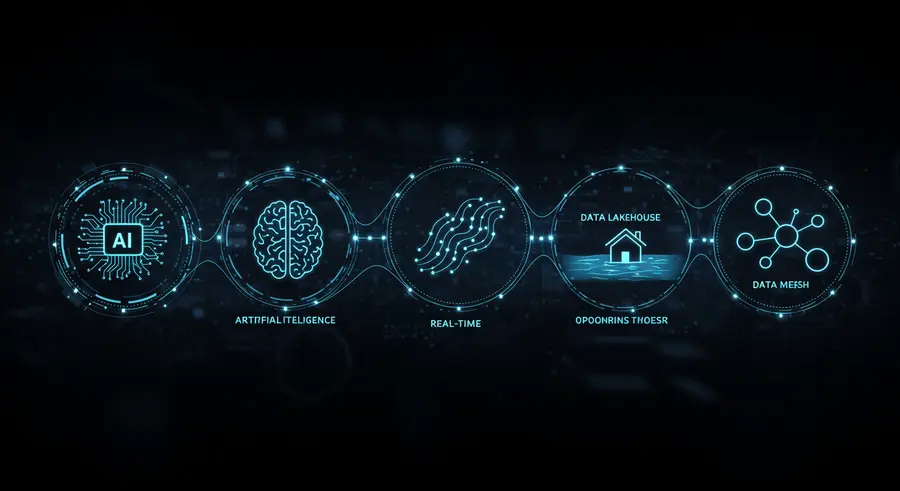Appearance

Welcome, data enthusiasts! 👋 Today, we're embarking on an exciting journey through the ever-evolving landscape of data architecture. In an era where data is often called the "new oil," understanding how to effectively store, process, and analyze it is paramount for any organization. We've come a long way from simple databases, and the journey continues to accelerate with the advent of AI, real-time analytics, and new paradigms like Data Lakehouses and Data Mesh.
This article takes inspiration from the foundational concepts discussed in our Modern Data Warehousing Concepts page, expanding on them to encompass the latest trends and architectural shifts.
🏛️ The Genesis: Traditional Data Warehouses
In the early days, the Data Warehouse (DW) was the king. It was a centralized repository designed for reporting and analysis, primarily handling structured data from various operational systems.
Key Characteristics:
- Structured Data: Optimized for relational data.
- ETL (Extract, Transform, Load): Data was cleaned, transformed, and loaded in batches.
- Schema-on-Write: Data schema defined upfront, ensuring data quality and consistency.
- Purpose: Business Intelligence (BI) and historical reporting.
Advantages: Consistency, data quality, optimized for complex queries. Challenges: Inflexible for new data types, slow for real-time needs, high cost, limited scalability for big data.
🌊 The Data Lake Emerges: Taming Big Data
As data volumes, velocities, and varieties exploded (the "3 Vs" of Big Data), the traditional DW struggled. Enter the Data Lake. A data lake is a vast, centralized repository that holds a massive amount of raw data in its native format until it's needed.
Key Characteristics:
- Raw Data: Stores structured, semi-structured, and unstructured data.
- ELT (Extract, Load, Transform): Data is loaded as-is, and transformation happens on read (schema-on-read).
- Scalability: Built on distributed storage like HDFS or cloud object storage (S3, ADLS).
- Purpose: Machine Learning (ML), advanced analytics, experimentation.
Advantages: Flexibility, scalability, cost-effective for large volumes, supports diverse data. Challenges: Data swamps (unmanaged data), governance issues, difficulty in discovering data, lack of ACID transactions.
🏠 The Best of Both Worlds: The Data Lakehouse
The Data Lakehouse architecture is the logical evolution, combining the best features of data warehouses and data lakes. It brings data warehousing capabilities (like ACID transactions, schema enforcement, and BI tools) directly to the data lake, often using open table formats like Delta Lake, Apache Iceberg, or Apache Hudi.
Key Characteristics:
- Unified Data: Handles both structured and unstructured data.
- ACID Transactions: Ensures data reliability and consistency.
- Performance: Optimized for both BI and ML workloads.
- Open Formats: Built on open-source data formats.
- Simplified Architecture: Reduces data duplication and complexity.
Advantages: Flexibility of data lake with reliability of data warehouse, real-time analytics, supports AI/ML directly on raw data. Challenges: Still a relatively new concept, requires specialized skills, evolving tooling.
🕸️ Decentralizing Data: The Data Mesh
While Lakehouses focus on technical architecture, the Data Mesh is a paradigm shift focusing on organizational and architectural decentralization. It treats data as a product, owned by domain-specific teams, which are responsible for its quality, accessibility, and discoverability.
Key Principles:
- Domain Ownership: Data responsibility shifts from centralized teams to domain teams.
- Data as a Product: Data is treated as a product with clear APIs, documentation, and quality standards.
- Self-Serve Data Platform: Centralized platform team provides tools and infrastructure for domain teams.
- Federated Computational Governance: Decentralized governance with global rules enforced automatically.
Advantages: Scalability, agility, promotes data ownership, faster time-to-insight for domain-specific data. Challenges: Significant organizational change, requires strong data literacy across teams, potential for data silos if not implemented carefully.
🧠 The AI and Real-Time Revolution
The integration of Artificial Intelligence (AI) and the demand for real-time analytics are accelerating the evolution of these architectures.
- AI in Data Warehousing: AI can automate ETL processes, optimize query performance, predict resource needs, and enhance data quality. Generative AI is also being explored for synthetic data generation and intelligent data cataloging.
- Real-Time Analytics: Modern data architectures are increasingly designed to support immediate insights. Data streaming technologies like Apache Kafka and Apache Flink are crucial for ingesting and processing data as it arrives, feeding into real-time dashboards and AI models. Data Lakehouses, with their ability to handle both streaming and batch data, are particularly well-suited for this.
🤔 Which Architecture is Right for You?
The choice of data architecture depends on your organization's specific needs, data volume, velocity, variety, and cultural readiness.
- Small to Medium Enterprises with Structured Data: A modern cloud data warehouse might suffice.
- Organizations with Big Data and ML Needs: A Data Lakehouse offers a powerful, flexible solution.
- Large, Decentralized Organizations with Diverse Data Needs: A Data Mesh can provide the necessary agility and ownership, though it requires significant organizational commitment.
Often, a hybrid approach combining elements of these architectures is the most pragmatic solution, leveraging the strengths of each.
🌟 Conclusion
The journey of data architecture is a dynamic one, constantly adapting to new technologies and business demands. From the structured reliability of data warehouses to the raw flexibility of data lakes, the unified power of lakehouses, and the decentralized agility of data mesh, each step brings us closer to a future where data truly empowers intelligent decision-making. By embracing these advancements and understanding their strengths, organizations can build robust, scalable, and insightful data platforms that drive innovation and competitive advantage. Keep exploring, keep learning, and keep building! 🚀